
A chisel is a tool with a characteristically shaped cutting edge of blade on its end; for carving or cutting a hard material such as wood, stone, or metal by hand, struck with a mallet, or mechanical power. The handle and blade of some types of chisel are made of metal or wood with a sharp edge in it.

An electrician is a tradesperson specializing in electrical wiring of buildings, transmission lines, stationary machines, and related equipment. Electricians may be employed in the installation of new electrical components or the maintenance and repair of existing electrical infrastructure. Electricians may also specialize in wiring ships, airplanes, and other mobile platforms, as well as data and cable lines.

Pliers are a hand tool used to hold objects firmly, possibly developed from tongs used to handle hot metal in Bronze Age Europe. They are also useful for bending and physically compressing a wide range of materials. Generally, pliers consist of a pair of metal first-class levers joined at a fulcrum positioned closer to one end of the levers, creating short jaws on one side of the fulcrum, and longer handles on the other side. This arrangement creates a mechanical advantage, allowing the force of the grip strength to be amplified and focused on an object with precision. The jaws can also be used to manipulate objects too small or unwieldy to be manipulated with the fingers.
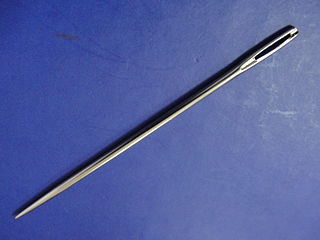
A sewing needle, used for hand-sewing, is a long slender tool with a pointed tip at one end and a hole to hold the sewing thread. The earliest needles were made of bone or wood; modern needles are manufactured from high carbon steel wire and are nickel- or 18K gold-plated for corrosion resistance. High-quality embroidery needles are plated with two-thirds platinum and one-third titanium alloy. Traditionally, needles have been kept in needle books or needlecases which have become objects of adornment. Sewing needles may also be kept in an étui, a small box that held needles and other items such as scissors, pencils and tweezers.

A wire stripper is a small, hand-held device used to strip the electrical insulation from electric wires.
Diagonal pliers are pliers intended for the cutting of wire. The plane defined by the cutting edges of the jaws intersects the joint rivet at an angle or "on a diagonal", hence the name.

A vise or vice is a mechanical apparatus used to secure an object to allow work to be performed on it. Vises have two parallel jaws, one fixed and the other movable, threaded in and out by a screw and lever.
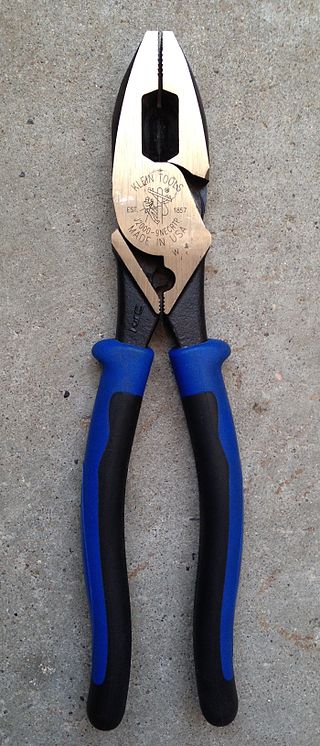
Lineman's pliers, Kleins, linesman pliers, side cutting linesman pliers and combination pliers are a type of pliers used by linemen, electricians, and other tradesmen primarily for gripping, twisting, bending and cutting wire, cable, and small metalwork components. They owe their effectiveness to their plier design, which multiplies force through leverage.

The fretsaw is a bow saw used for intricate cutting work which often incorporates tight curves. The tool takes its name from its use in fretwork. Although traditionally intended for woodwork, different blades increase the versatility of this saw.
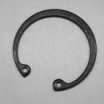
A circlip, also known as a C-clip, rotor clip, snap ring, or Jesus clip, is a type of fastener or retaining ring consisting of a semi-flexible metal ring with open ends that can be snapped into place into a machined groove on a dowel pin or other part to permit rotation but to prevent axial movement. There are two basic types of circlips: internal and external. Circlips are often used to secure pinned connections.
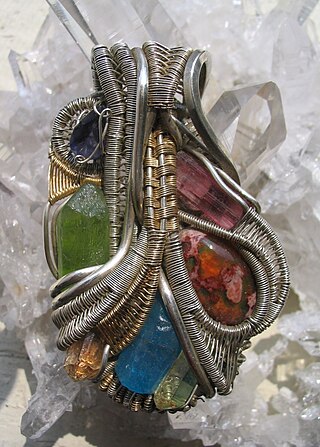
Wire wrapping is one of the oldest techniques for making handmade jewelry. This technique is done with jewelry wire and findings similar to wire to make components. Wire components are then connected to one another using mechanical techniques with no soldering or heating of the wire. Frequently, in this approach, a wire is bent into a loop or other decorative shape and then the wire is wrapped around itself to finish the wire component. This makes the loop or decorative shape permanent. The technique of wrapping wire around itself gives this craft its name of wire wrapping.

A multi-tool is a hand tool that combines several individual functions in a single unit. The smallest are credit-card or key sized units designed for carrying in a wallet or on a keyring, but others are designed to be carried in a trouser pocket or belt-mounted pouch.

A surgical suture, also known as a stitch or stitches, is a medical device used to hold body tissues together and approximate wound edges after an injury or surgery. Application generally involves using a needle with an attached length of thread. There are numerous types of suture which differ by needle shape and size as well as thread material and characteristics. Selection of surgical suture should be determined by the characteristics and location of the wound or the specific body tissues being approximated.

A needle threader is a device for helping to put thread through the eye of a needle. Many kinds exist, though a common type combines a short length of fine wire bent into a diamond shape, with one corner held by a piece of tinplate or plastic. The user passes the wire loop through the needle eye, passes the string through the wire loop, and finally pulls both the loop back through the needle by the handle, which pulls the thread through. The typical needle threader of this type has the image of a woman, possibly Ariadne, in profile stamped into the plate handle.

A kitchen scraper is a kitchen implement made of metal, plastics, wood, rubber or silicone rubber. In practice, one type of scraper is often interchanged with another or with a spatula for some of the various uses.

Locking pliers are pliers that can be locked into position, using an "over-center" cam action. Locking pliers are available with many different jaw styles, such as needle-nose pliers, wrenches, clamps and various shapes to fix metal parts for welding. They also come in many sizes.
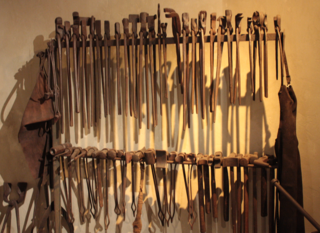
Pincers are a hand tool used in many situations where a mechanical advantage is required to pinch, cut or pull an object. Pincers are first-class levers, but differ from pliers in that the concentration of force is either to a point, or to an edge perpendicular to the length of the tool. This allows pincers to be brought close to a surface, which is often required when working with nails.
Channellock is an American company that produces hand tools. It is best known for its pliers—the company manufactures more than 140 types of pliers—particularly its eponymous style of tongue-and-groove, slip-joint pliers. Its pliers have distinctive sky-blue handle grips; the company has been using the same trademarked shade of blue since 1956.

Tongue-and-groove pliers are a type of slip-joint pliers. They are also known as:

A jigsaw is a saw which uses a reciprocating blade to cut irregular curves, such as stenciled designs, in wood, metal, or other materials.



















